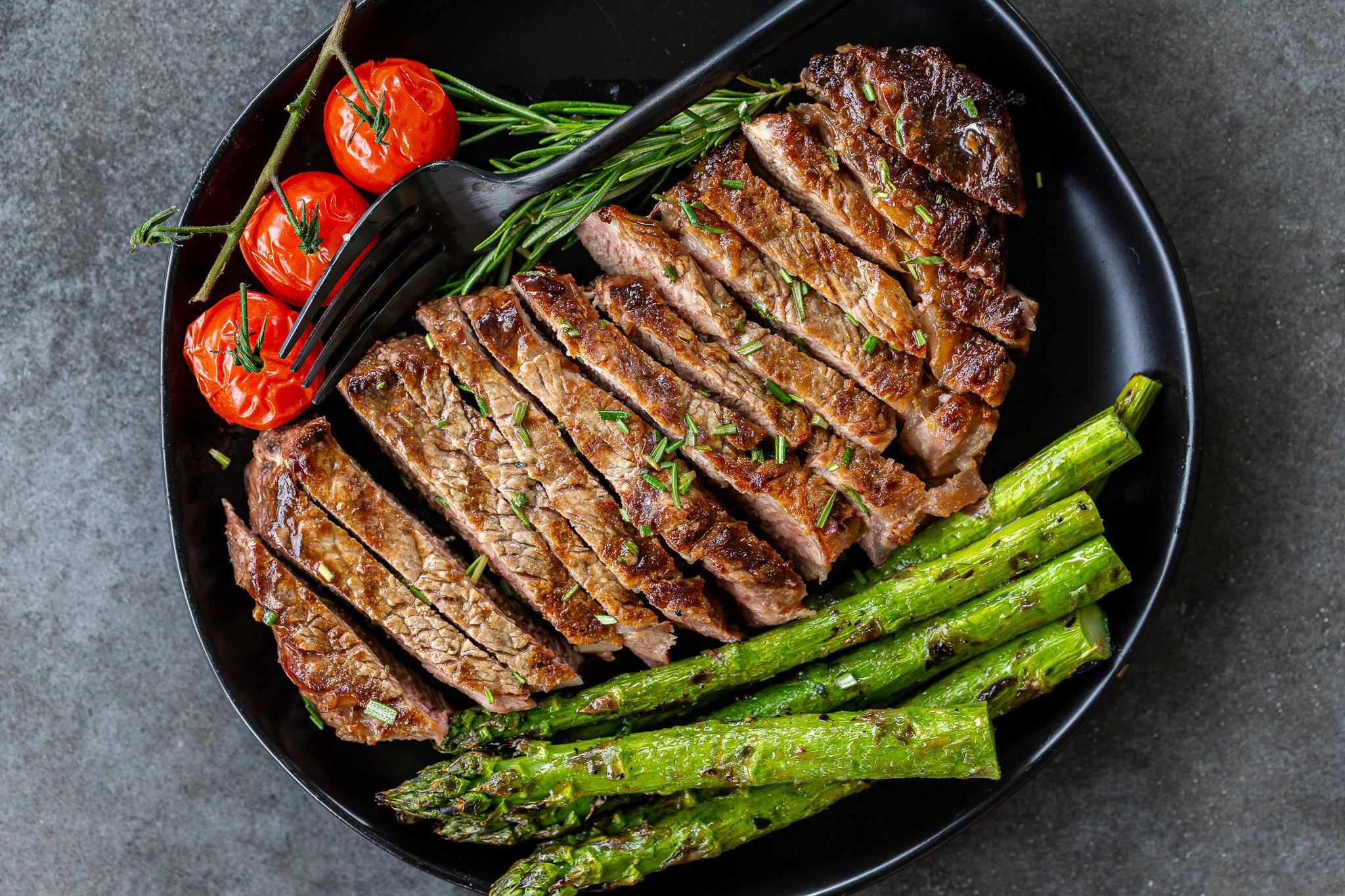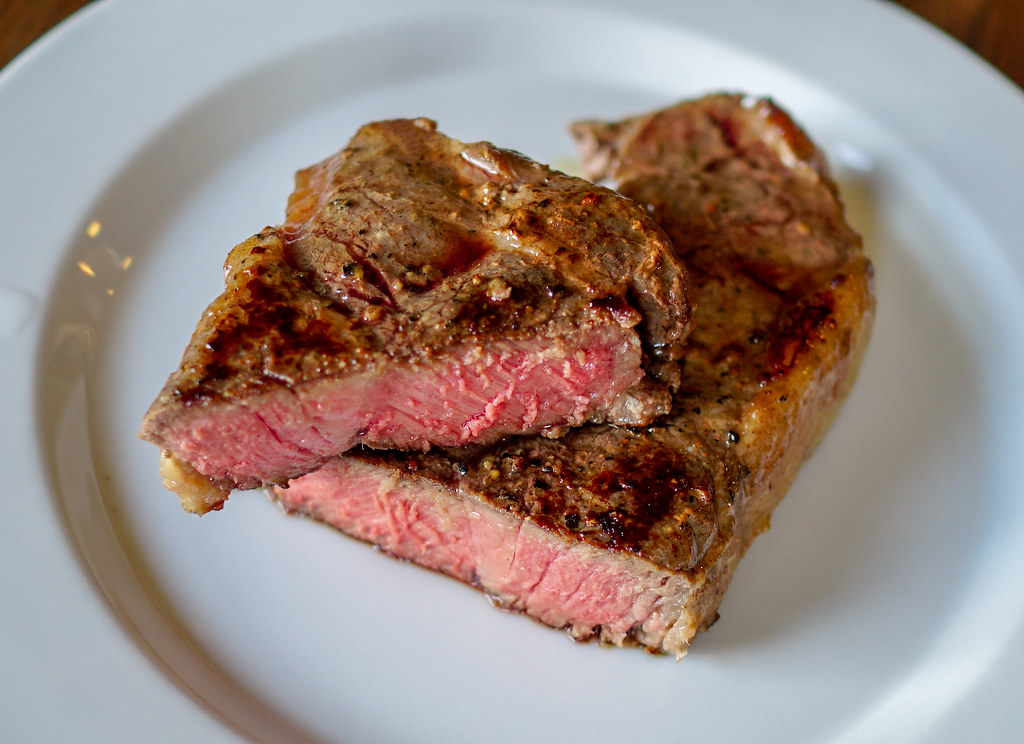
Before you start cooking the steak it is important to know how long it should cook. There is no exact time, so you can cook the steak to your liking. The size of the steak, and the temperature of oven will influence the time required. After this stage, the steak should rest for five to 10 minutes before you slice it. To serve the steak with butter, place it on a serving plate.
One tablespoon (15 milliliters) of vegetable oil should be heated on medium heat while you prepare the steak. Put the oil in an oven-safe pot. Once the oil is hot enough to light smoke the steak, heat it up. Make sure you remove the steak from the pan before it starts to burn. If you're using olive oil, you can also sear the steak with butter. However, butter starts smoking at a lower temperature than olive, so you should use it sparingly. Before you cook the steak, rub it with the oil.

Once the steak has rested, you can start cooking it. It's best to start it the night before. It'll save you time and help you save effort by cooking the steak ahead. After you have prepared the steak, it should be placed in the refrigerator overnight for it to rest. It is best to prepare it the night prior so it is still at room temperature. The steak can be finished in the oven to get a tender and succulent steak.
Before you bake the steak, ensure that the crust is well-browned. Before you put the steak in the oven, sear it. It will seal the taste and give it a high-end finish. Next, heat the oven at 400F. Depending on the size of your steak, the cooking process will take approximately 30 minutes. The steak should rest between thirty and forty minutes.
The final step in finishing the steak in the oven is to make it medium-rare. It is done when the top of the steak is firm, and the middle is still pink. It should then be baked at 350 degrees. The internal temperature of your steak should not exceed 145°F. Broil the steak for 19 to 21 mins for medium-rare. You can then broil it in the oven another seven to 10 minutes.

The final step in finishing the steak is to finish the process in the oven. The steak should achieve a temperature of 135 to 140 degrees Fahrenheit. The thickness and thickness of the steak will determine the cooking time. After the steak is finished, allow it to rest for a few minutes and then slice it across the grain. To ensure a perfect end, bake the steak for 20 minutes after it is done cooking.
FAQ
Do I need any special equipment to cook?
It doesn't take any special equipment or tools to learn to cook. However, the right tools can make it easier to cook. To make pasta easier, you can use a knife to cut the pasta and a whisk to whip up egg whites to stiff peaks. It makes cooking much easier and quicker.
How can I motivate myself to cook?
Sharing food with friends and family is a great way to have fun cooking. It is easier to cook for yourself than for others. If you want to be motivated to cook, try making something new. This will help you learn about new techniques and ingredients. Also, you can use recipes from different cultures to expand your culinary knowledge.
How much does a culinary school cost?
Culinary school costs vary depending on where you go, how long you study, and what program you choose. The annual tuition average is between $10,000 and $30,000 Students graduate with approximately $20,000 of debt. However, some programs offer scholarships, grants, and work-study opportunities.
Do I need to buy any ingredients to cook?
You don't have to buy all ingredients. Many grocery stores have premade sauces and other products that you can substitute for. Premade meals are an option if you're looking for a way to save some money.
Are there any requirements to become a chef?
No. No. Some even went on to culinary school to gain work experience. But most chefs prefer culinary school as it offers them more opportunities for learning and growth. Culinary schools give students hands-on experience, which allows them to develop valuable skills as well as improve their culinary knowledge.
What's the difference between a professional chef and an amateur cook?
A chef prepares meals for others. A cook cooks for others. Both jobs require the preparation of food. However, chefs work directly with their customers. This means they may have to decide what to serve guests based on their preferences. A cook doesn't need to interact with clients. Instead, they ensure that the food tastes delicious before they serve it to others.
What can I learn about cooking?
There are many cooking classes available all over the country. There are many schools that offer courses in pastry, baking, and wine tasting. You can learn more about how to cook by enrolling in a class at either a local vocational school or community college.
Statistics
- You'll be amazed that over 90% of CIA students receive scholarships and grants to finish their culinary studies. (ischoolconnect.com)
- On average, chefs earn $58,740 a year, according to the BLS. - learnhowtobecome.org
- In the United States, the category is estimated at $23.2 billion annually and is growing faster than the market. (washingtonpost.com)
External Links
How To
How to make the perfect omelet
Omelets are a favorite breakfast food of mine. How can you make them perfectly? I've tried many recipes and different methods but none have worked. So I am sharing some tips and tricks today to help you make fluffy, delicious omelets every morning.
It is important to know that eggs can be temperamental when making omelets. You must get them fresh, organically, and keep them cold until you cook. The yolks and whites will not form properly if they aren't kept cold enough. This makes your omelets look weirdly colored. If you're going to cook them immediately, it is best if the eggs are still warm.
Another tip is to separate the egg before adding it to the pan. You don't want the white to get mixed with the yolk, as this could cause the egg to curdle.
The egg can burn if it is placed directly on the stovetop. Instead, microwave the egg for 10 seconds before adding it to the pan. The microwave heat cooks your egg just right, without it becoming too soft.
Next, let's discuss mixing the eggs. Mixing eggs together is important. You need to beat them well. You need to turn the bowl of the mixer upside down. Now shake the bowl vigorously. The egg will be thoroughly mixed in the bowl as the air is whipped.
The fun part is now - adding the milk to the mixture. Fold the eggs in the milk mixture by first pouring half of it into the egg whites. Do not be alarmed if there are still egg streaks visible. Once the omelet flips, these streaks will disappear.
After you have folded the eggs, heat the oil in a pan over medium heat. Once the oil has started to sizzle, turn the heat down to low. Once the oil has gotten hot, add 1/4 cup of butter and swirl it around so that the entire pan is coated. Carefully open the pan's lid and add salt to the pan. Salt will prevent the omelet sticking to the pan.
Cover the pan once the omelet is formed and allow it to cool completely. Use a spatula to flip the omelet or turn the pan upside-down. Cook the other side for another minute or two. Serve the omelet immediately by removing it from the pan.
This recipe works best when you use whole milk.